Mark Armitage is the Soil Farmer of the Year for 2022. The award presented by Biodiversity, Agriculture, Soil, Environment (BASE) Ireland aims to acknowledge the good work of its members, while remembering one of the group’s founders, Philip Reck, who died tragically in a workplace accident in March 2021.
When you walk on to Mark’s farm in north Tipperary you find, for a soil farmer of the year, he seems like a pretty normal guy. The farmyard is also fairly standard, it’s a mixed enterprise with cattle and tillage. Then, as you get into conversation, you realise why Mark has received the prestigious award and that things don’t have to be too complicated to look after your soil.
First of all he has plenty of different soil types on his farm and it’s not all plain sailing. There are large rocks visible in the first field we go into and really there isn’t much soil at all.
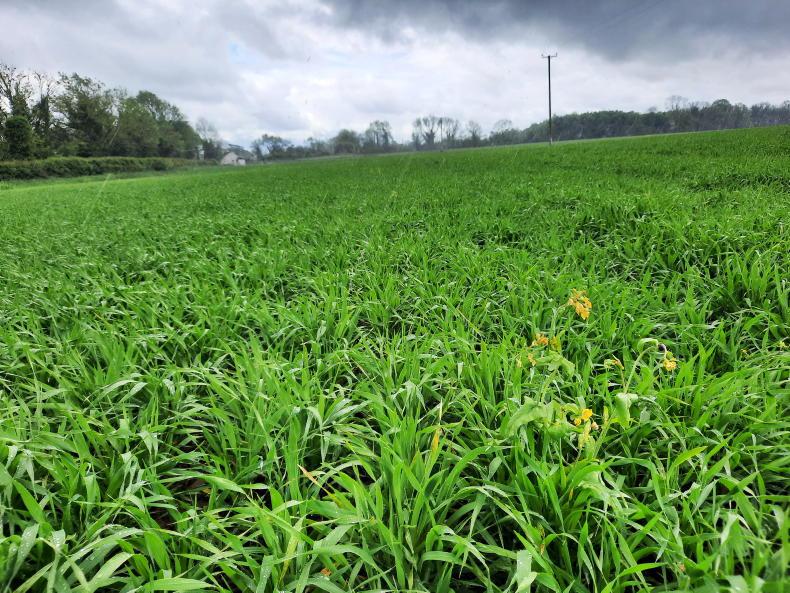
Spring barley in late May after receiving a herbicide and nutrition.
This of course makes for good grazing ground in the wet, but also makes silage harvesting difficult. In the same land block, but further down a valley, the ground is much wetter. It’s peaty-type soil.
Mark farms with his father Victor and the cattle they rear are stabilisers with some Angus cross. They practice mob grazing. Large groups of cattle go into heavy covers and graze the grass off quickly. They were ready to be moved when we surveyed the herd.
The cows and calves are divided into three groups with approximately 45 cows with their calves in each group. They move between 5ac paddocks every four to five days.
“Grass would be high, most people would say it should be left for silage. When you put cows into grass that high they’re very content and it slows down the rotation.”
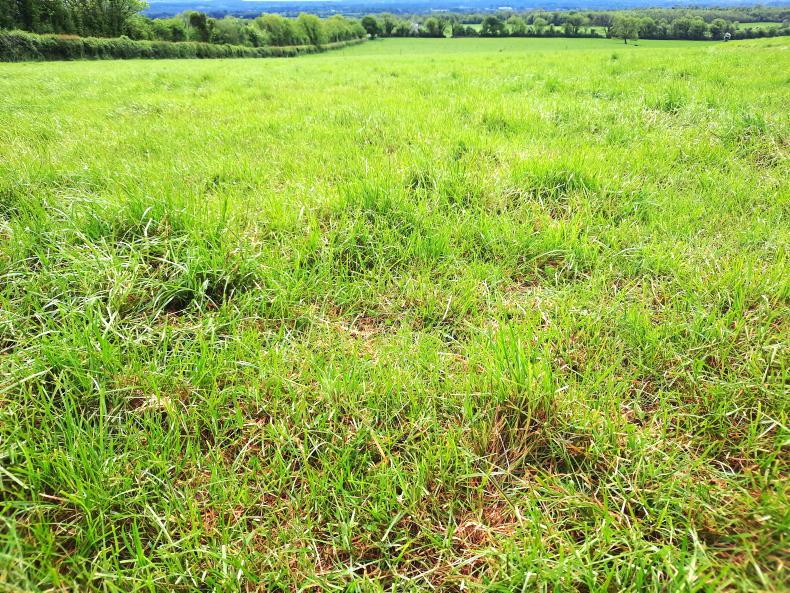
A paddock approximately 10 days after grazing with 45 cows and their calves.
That rotation is about 45 days long, giving the grass and soil a 40-day rest period. Mark adds that this gives the soil time to rest, while the heavy covers are also a help to cover the soil and prevent compaction and erosion.
Nitrogen use
Very little nitrogen has been spread on the grazing paddocks in recent years. Mark explained that the paddocks get 24 units of nitrogen per acre at the beginning of the season to get growth going and another 24 units are spread towards the back end of the grazing season. Watery slurry is used in between times.
“The clover is coming back naturally itself,” Mark said and he places clover content at approximately 15% on the grazing ground.
Soil pH is at about 6.4/6.5 which is important for clover establishment and maintenance. Soil pH improved, Mark thinks, with the application of kieserite, which contains magnesium sulphate.
Mark is unsure if this is due to the sulphur effect or if magnesium was needed.
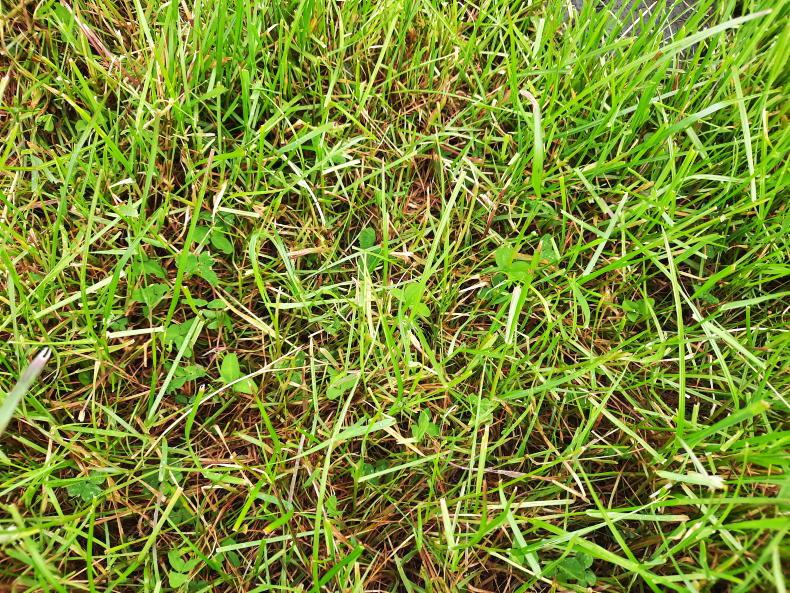
Clover is naturally coming back on the farm since nitrogen fertiliser rates have been cut.
“The pH might be right but you mightn’t have the calcium. You might have the same pH over the farm, but your balances of magnesium and calcium could be different. Magnesium has 1.6 times the neutralising value of calcium so we were spreading magnesium and it was bringing up the pH as well.”
Grass tetany
Mark noted that grass tetany was an issue on the farm before and some of the fields were identified as causing particular problems. Mark took some Albrecht soil samples and these fields came back with higher K levels than magnesium.
The plant was taking up too much K and they spread a lot of kieserite to bring up magnesium levels and rectify this problem. The issues with grass tetany went away, but high magnesium licks are given to the cows as well.
The cows receive seaweed licks before calving. And seaweed is also added to the silage at harvesting, it’s high in iodine, to promote healthy growth in animals.
Calves at grass
Mark is a strong believer in doing simple things that make a big difference. For instance, he added Angus to the herd as they were polled (polled stabiliser cattle are now being brought back into the herd as well). As they didn’t need to be dehorned Mark said after calving the cows and calves are out to grass within a day or two. They’re tagged, entered into the ICBF app on the phone and let out into the open air.
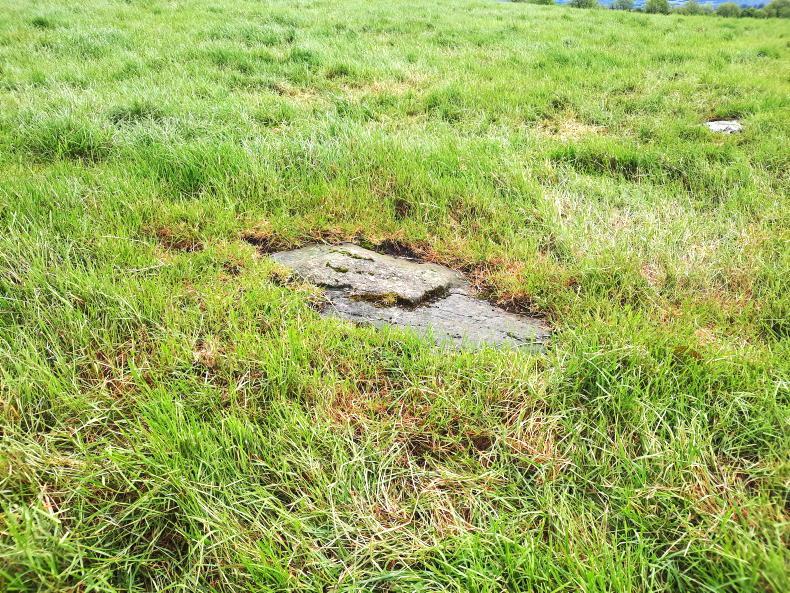
There is only about 1in of soil in parts of the farm.
Calving takes place in mid-March, April and May, but the majority occurs over a five-week period. At the end of February cattle begin to move to the mart and there is plenty of straw bedding for cows and calves. Before this, cows are in a cubicle shed with access to the yard and they feed off the face of the pit. Only cows with twins receive meal.
Once weaned the weanlings are placed on straw and move onto slats before calving starts in the spring time. Weaning usually takes place outside to avoid stress in the heat of the shed and a risk of pneumonia.

This paddock which was ready to be grazed in on some of the wetter land on the farm.
This has taken out the need for vaccination against pneumonia. The cattle on their second winter are sold from about 21-24 months on to the mart at a weight of about 580-600kg. These animals receive 5kg of meal per day from October to February or March.
Outwintering
About 45 weanlings are outwintered on a catch crop. This can be grazed from 1 December on and they also have access to grass.
The cover crop is grown on the land which grows 45ac of spring barley.
As this ground is planted back into a cover crop, the crop diversification requirement is adhered to. Again, there is a large focus on balancing nutrients here and some nutrition is applied in foliar form if needed along with a fungicide or herbicide.
Aphicides are not used on the farm. Aside from their use being hit and miss, Mark is trying to protect the predators that may help to control the aphids and which are also beneficial to the environment around him.
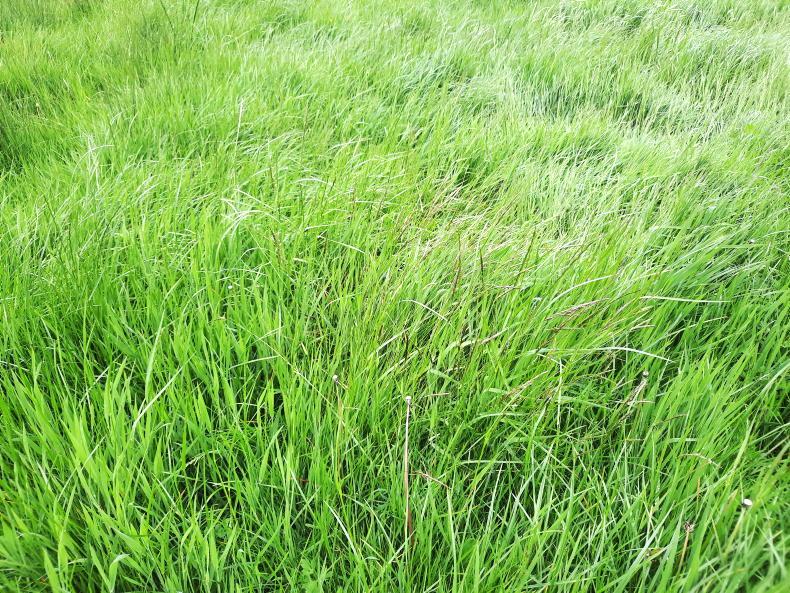
A paddock ready to be grazed.
The cover crop is direct drilled as soon as possible after harvest. A few different mixes are purchased and those mixes are added together and usually contain crops like forage rape, stubble turnips, fodder radish, phacelia, vetch, linseed and volunteer barley.
The crop is grazed in 5ac blocks and the animals have access to grass as well. A large area is given at a time to avoid compaction and this is also why a strip wire is not used as compaction can occur under the wire.
The catch crop helps to take up nutrients, while helping to improve soil structure and as light animals are grazing and managed, there is a low risk of compaction.
Adding the animals to the rotation helps with soil health by breaking down the catch crop.
Direct drill
Mark then goes back into the field in the spring time with his John Deere 750A direct drill.
He was one of the first farmers in the country to purchase a modern direct drill and he actually ended up sowing crops for other farmers and hiring the drill to people interested in changing their tillage system.
Philip Reck Soil Farmer of the Year Award
2022 is the inaugural year of The Philip Reck Soil Farmer of the Year Award and it was presented to Mark by Philip’s mother Anne in May.
Philip was a believer in farmers educating farmers and this is what BASE Ireland is all about. He had a passion for cover crops and finding mixes that would perform different jobs in the soil. His goal was to balance nutrients and he was a mine of knowledge on the subject.
This led to his interest in the Albrecht soil balancing system and he encouraged many others like Mark to try the Albrecht soil tests and work to balance their soils.
Philip’s legacy will live on in this award and this will encourage more farmers to try and improve their soil health and work together to educate each other.
Albrecht soil tests
The Albrecht System of Soil Fertility was developed by Dr William A Albrecht and is based on feeding the soil to feed the plants. If the soil contains the right chemistry then the plant should be able to acquire the nutrients it needs and in the correct amounts. The system uses soil chemistry to affect soil physics and this should affect the environment and the biology of the soil.
Mark Armitage is the Soil Farmer of the Year for 2022. The award presented by Biodiversity, Agriculture, Soil, Environment (BASE) Ireland aims to acknowledge the good work of its members, while remembering one of the group’s founders, Philip Reck, who died tragically in a workplace accident in March 2021.
When you walk on to Mark’s farm in north Tipperary you find, for a soil farmer of the year, he seems like a pretty normal guy. The farmyard is also fairly standard, it’s a mixed enterprise with cattle and tillage. Then, as you get into conversation, you realise why Mark has received the prestigious award and that things don’t have to be too complicated to look after your soil.
First of all he has plenty of different soil types on his farm and it’s not all plain sailing. There are large rocks visible in the first field we go into and really there isn’t much soil at all.

Spring barley in late May after receiving a herbicide and nutrition.
This of course makes for good grazing ground in the wet, but also makes silage harvesting difficult. In the same land block, but further down a valley, the ground is much wetter. It’s peaty-type soil.
Mark farms with his father Victor and the cattle they rear are stabilisers with some Angus cross. They practice mob grazing. Large groups of cattle go into heavy covers and graze the grass off quickly. They were ready to be moved when we surveyed the herd.
The cows and calves are divided into three groups with approximately 45 cows with their calves in each group. They move between 5ac paddocks every four to five days.
“Grass would be high, most people would say it should be left for silage. When you put cows into grass that high they’re very content and it slows down the rotation.”

A paddock approximately 10 days after grazing with 45 cows and their calves.
That rotation is about 45 days long, giving the grass and soil a 40-day rest period. Mark adds that this gives the soil time to rest, while the heavy covers are also a help to cover the soil and prevent compaction and erosion.
Nitrogen use
Very little nitrogen has been spread on the grazing paddocks in recent years. Mark explained that the paddocks get 24 units of nitrogen per acre at the beginning of the season to get growth going and another 24 units are spread towards the back end of the grazing season. Watery slurry is used in between times.
“The clover is coming back naturally itself,” Mark said and he places clover content at approximately 15% on the grazing ground.
Soil pH is at about 6.4/6.5 which is important for clover establishment and maintenance. Soil pH improved, Mark thinks, with the application of kieserite, which contains magnesium sulphate.
Mark is unsure if this is due to the sulphur effect or if magnesium was needed.

Clover is naturally coming back on the farm since nitrogen fertiliser rates have been cut.
“The pH might be right but you mightn’t have the calcium. You might have the same pH over the farm, but your balances of magnesium and calcium could be different. Magnesium has 1.6 times the neutralising value of calcium so we were spreading magnesium and it was bringing up the pH as well.”
Grass tetany
Mark noted that grass tetany was an issue on the farm before and some of the fields were identified as causing particular problems. Mark took some Albrecht soil samples and these fields came back with higher K levels than magnesium.
The plant was taking up too much K and they spread a lot of kieserite to bring up magnesium levels and rectify this problem. The issues with grass tetany went away, but high magnesium licks are given to the cows as well.
The cows receive seaweed licks before calving. And seaweed is also added to the silage at harvesting, it’s high in iodine, to promote healthy growth in animals.
Calves at grass
Mark is a strong believer in doing simple things that make a big difference. For instance, he added Angus to the herd as they were polled (polled stabiliser cattle are now being brought back into the herd as well). As they didn’t need to be dehorned Mark said after calving the cows and calves are out to grass within a day or two. They’re tagged, entered into the ICBF app on the phone and let out into the open air.

There is only about 1in of soil in parts of the farm.
Calving takes place in mid-March, April and May, but the majority occurs over a five-week period. At the end of February cattle begin to move to the mart and there is plenty of straw bedding for cows and calves. Before this, cows are in a cubicle shed with access to the yard and they feed off the face of the pit. Only cows with twins receive meal.
Once weaned the weanlings are placed on straw and move onto slats before calving starts in the spring time. Weaning usually takes place outside to avoid stress in the heat of the shed and a risk of pneumonia.

This paddock which was ready to be grazed in on some of the wetter land on the farm.
This has taken out the need for vaccination against pneumonia. The cattle on their second winter are sold from about 21-24 months on to the mart at a weight of about 580-600kg. These animals receive 5kg of meal per day from October to February or March.
Outwintering
About 45 weanlings are outwintered on a catch crop. This can be grazed from 1 December on and they also have access to grass.
The cover crop is grown on the land which grows 45ac of spring barley.
As this ground is planted back into a cover crop, the crop diversification requirement is adhered to. Again, there is a large focus on balancing nutrients here and some nutrition is applied in foliar form if needed along with a fungicide or herbicide.
Aphicides are not used on the farm. Aside from their use being hit and miss, Mark is trying to protect the predators that may help to control the aphids and which are also beneficial to the environment around him.

A paddock ready to be grazed.
The cover crop is direct drilled as soon as possible after harvest. A few different mixes are purchased and those mixes are added together and usually contain crops like forage rape, stubble turnips, fodder radish, phacelia, vetch, linseed and volunteer barley.
The crop is grazed in 5ac blocks and the animals have access to grass as well. A large area is given at a time to avoid compaction and this is also why a strip wire is not used as compaction can occur under the wire.
The catch crop helps to take up nutrients, while helping to improve soil structure and as light animals are grazing and managed, there is a low risk of compaction.
Adding the animals to the rotation helps with soil health by breaking down the catch crop.
Direct drill
Mark then goes back into the field in the spring time with his John Deere 750A direct drill.
He was one of the first farmers in the country to purchase a modern direct drill and he actually ended up sowing crops for other farmers and hiring the drill to people interested in changing their tillage system.
Philip Reck Soil Farmer of the Year Award
2022 is the inaugural year of The Philip Reck Soil Farmer of the Year Award and it was presented to Mark by Philip’s mother Anne in May.
Philip was a believer in farmers educating farmers and this is what BASE Ireland is all about. He had a passion for cover crops and finding mixes that would perform different jobs in the soil. His goal was to balance nutrients and he was a mine of knowledge on the subject.
This led to his interest in the Albrecht soil balancing system and he encouraged many others like Mark to try the Albrecht soil tests and work to balance their soils.
Philip’s legacy will live on in this award and this will encourage more farmers to try and improve their soil health and work together to educate each other.
Albrecht soil tests
The Albrecht System of Soil Fertility was developed by Dr William A Albrecht and is based on feeding the soil to feed the plants. If the soil contains the right chemistry then the plant should be able to acquire the nutrients it needs and in the correct amounts. The system uses soil chemistry to affect soil physics and this should affect the environment and the biology of the soil.












 This is a subscriber-only article
This is a subscriber-only article










SHARING OPTIONS: